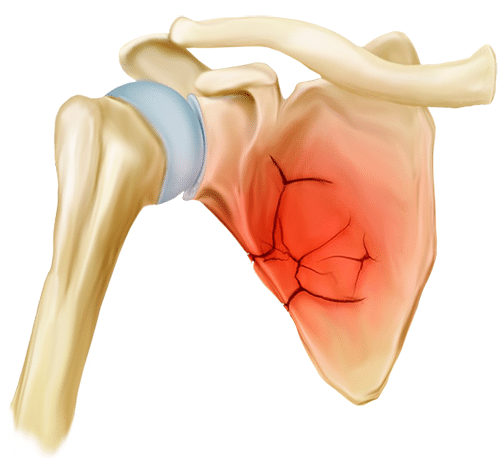
What is Scapula?
A scapula fracture (broken shoulder blade) only occurs in less than 1 percent of the time. The scapula is a bony construction on the upper back. It connects the upper arm to the thorax (chest.) This part also controls the shoulder joint which connects the upper arm to the socket. The shoulder blade is surrounded by thick layers of muscle. And these muscles are responsible for the smooth movement of the shoulder.
When a fracture occurs, it’s usually due to direct trauma. Although rarely broken. And occurs more often in men from the age of 25-45. A broken shoulder blade is often caused by a violent force.
Causes of a Broken Shoulder Blade
When a scapula fracture occurs it is due to direct trauma such as force. In nearly 80 percent of broken shoulder blades, additional injuries such as to the chest wall, lunches, and shoulder occur.
A scapula fracture most commonly occurs in the following:
- Car accidents
- Direct trauma and falls to the shoulder
- Trauma such as from a baseball bat or hammer
- Falling on an outstretched hand
Symptoms of a Scapula Fracture
When a broken shoulder blade happens, pain and swelling are the most common symptoms.
Additional signs of a broken shoulder blade, such as:
- Holding the injured arm close to the body
- Inability to lift the arm
- Moving the arm increases the pain
- Having pain with each deep breath due to the movement of the chest wall with each breath; this movement may, in turn, move the shoulder blade, causing pain.
- The shoulder appears flattened or deformed
Treatment for a scapula Fracture
It’s important to first be seen by an orthopedic. When treating a broken shoulder blade, however, the goal is to restore the function of the shoulder. It’s common for a scapula fracture to be treated without surgery. However, there are some cases in which the fracture is too severe and may need surgical intervention.
First, ice is used for swelling and pain medicine for shoulder pain. The shoulder is then immobilized for a few weeks until the pain subsides.
Physical therapy is good in the early stages. It will help you improve the range of motion. This is usually started within a week of the injury. If you do not take the proper precautions early on, you may develop a frozen shoulder.
Surgical treatment may be necessary. These are typically those involving the shoulder socket or neck. Early detection of this is important to help determine the best option for you. It’s important to receive ongoing treatment with an orthopedic throughout your recovery.
If you are experiencing shoulder pain, call us immediately at 888-409-8006. Offices conveniently located throughout South Florida.
